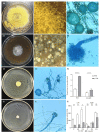The Deletion of LeuRS Revealed Its Important Roles in Osmotic Stress Tolerance, Amino Acid and Sugar Metabolism, and the Reproduction Process of Aspergillus montevidensis
- PMID: 38248946
- PMCID: PMC10820851
- DOI: 10.3390/jof10010036
The Deletion of LeuRS Revealed Its Important Roles in Osmotic Stress Tolerance, Amino Acid and Sugar Metabolism, and the Reproduction Process of Aspergillus montevidensis
Abstract
Aspergillus montevidensis is an important domesticated fungus that has been applied to produce many traditional fermented foods under high osmotic conditions. However, the detailed mechanisms of tolerance to osmotic stress remain largely unknown. Here, we construct a target-deleted strain (ΔLeuRS) of A. montevidensis and found that the ΔLeuRS mutants grew slowly and suppressed the development of the cleistothecium compared to the wide-type strains (WT) under salt-stressed and non-stressed conditions. Furthermore, differentially expressed genes (p < 0.001) governed by LeuRS were involved in salt tolerance, ABC transporter, amino acid metabolism, sugar metabolism, and the reproduction process. The ΔLeuRS strains compared to WT strains under short- and long-term salinity stress especially altered accumulation levels of metabolites, such as amino acids and derivatives, carbohydrates, organic acids, and fatty acids. This study provides new insights into the underlying mechanisms of salinity tolerance and lays a foundation for flavor improvement of foods fermented with A. montevidensis.
Keywords: Aspergillus montevidensis; leucyl-tRNA synthetase; metabolome; osmotic tolerance; transcriptome.
Conflict of interest statement
The authors declare no conflicts of interest.
Figures






Similar articles
-
Morphological, transcriptional, and metabolic analyses of osmotic-adapted mechanisms of the halophilic Aspergillus montevidensis ZYD4 under hypersaline conditions.Appl Microbiol Biotechnol. 2019 May;103(9):3829-3846. doi: 10.1007/s00253-019-09705-2. Epub 2019 Mar 11. Appl Microbiol Biotechnol. 2019. PMID: 30859256
-
Morphological and Transcriptomic Analysis Reveals the Osmoadaptive Response of Endophytic Fungus Aspergillus montevidensis ZYD4 to High Salt Stress.Front Microbiol. 2017 Sep 21;8:1789. doi: 10.3389/fmicb.2017.01789. eCollection 2017. Front Microbiol. 2017. PMID: 28983284 Free PMC article.
-
Transcriptomic and metabolomic analyses reveal mechanisms of adaptation to salinity in which carbon and nitrogen metabolism is altered in sugar beet roots.BMC Plant Biol. 2020 Apr 3;20(1):138. doi: 10.1186/s12870-020-02349-9. BMC Plant Biol. 2020. PMID: 32245415 Free PMC article.
-
Metabolomics-mediated elucidation of rice responses to salt stress.Planta. 2023 Nov 3;258(6):111. doi: 10.1007/s00425-023-04258-1. Planta. 2023. PMID: 37919614 Review.
-
Understanding the roles of osmolytes for acclimatizing plants to changing environment: a review of potential mechanism.Plant Signal Behav. 2021 Aug 3;16(8):1913306. doi: 10.1080/15592324.2021.1913306. Epub 2021 Jun 16. Plant Signal Behav. 2021. PMID: 34134596 Free PMC article. Review.
References
-
- Park H.S., Jun S.C., Han K.H., Hong S.B., Yu J.H. Diversity, application, and synthetic biology of industrially important Aspergillus fungi. Adv. Appl. Microbiol. 2017;100:161–202. - PubMed
-
- Ryu J.A., Kim E., Yang S.M., Lee S., Yoon S.R., Jang K.S., Kim H.Y. High-throughput sequencing of the microbial community associated with the physicochemical properties of meju (dried fermented soybean) and doenjang (traditional Korean fermented soybean paste) LWT. 2021;146:111473. doi: 10.1016/j.lwt.2021.111473. - DOI
Grants and funding
LinkOut - more resources
Full Text Sources

